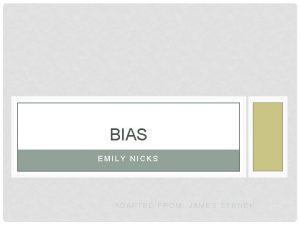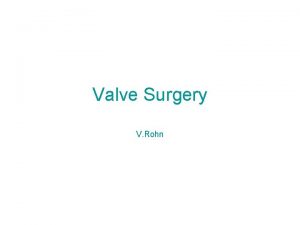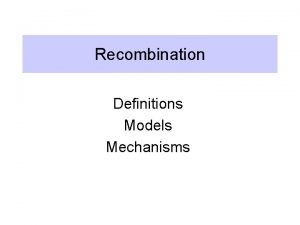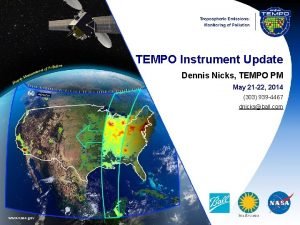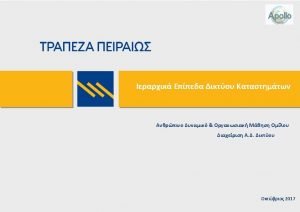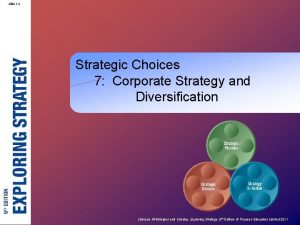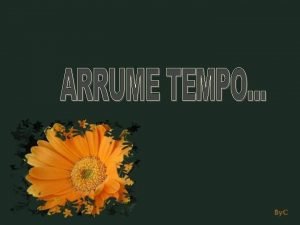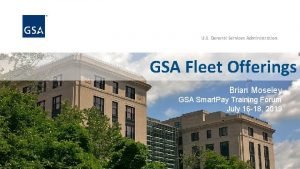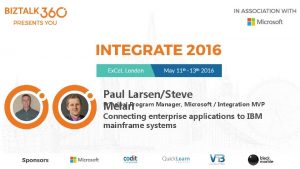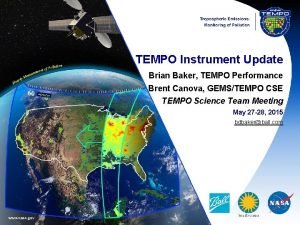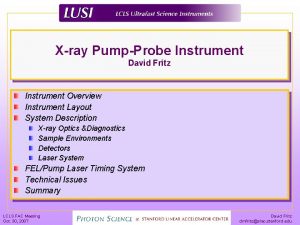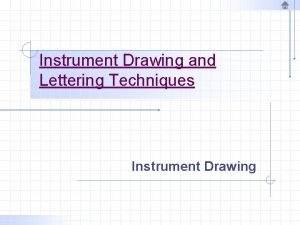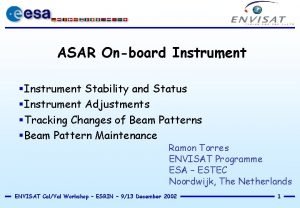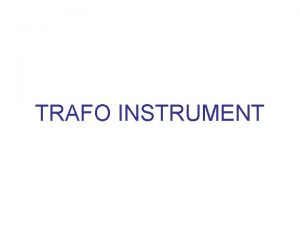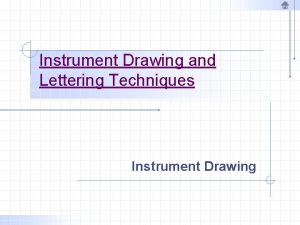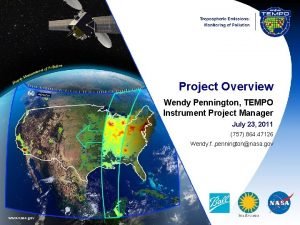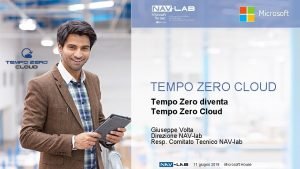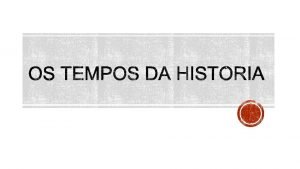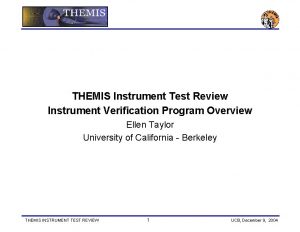TEMPO Instrument Update Dennis Nicks Program Manager TEMPO















- Slides: 15

TEMPO Instrument Update Dennis Nicks, Program Manager TEMPO Science Team Meeting June 1 -2, 2016 dnicks@ball. com

Ball TEMPO Program Status Ø Instrument CDR completed in June 2015 • Successful review with positive comments from review board • All instrument action items closed Ø Flight CCDs selected in February 2016 • New Lot 3 B parts with extended etch process resulted in lower dark current over Lot 1 parts • Predicted instrument performance achieves Level 1 Baseline Science requirements Ø Subsystems are completed or in processing / final test • Subsystems either meet requirements, or have acceptable performance when considering system level margin 6/1/2016 2

TEMPO Operations: Step / Stare Imaging over Field of Regard Parameter Current Best Estimate Frame Integration Time 118 ms Image Frame Rate 7. 92 Hz Image Frame Time 2. 65 s Number of Coadds 21 Scan Mirror Step Size 114 µrad Number of Scan Mirror Steps 1283 Coverage Time 6/1/2016 59. 1 min TEMPO step / stares over GNA in 1283 steps from East to West over 59. 1 min Ground processing spatially bins and geo-locates image Images from each scan mirror position are co-added on board Transmit co-added images to ground 3

TEMPO Mechanical Design Changes from PDR to CDR 6/1/2016 4

TEMPO Instrument: Expanded View 6/1/2016 5

Subsystems In Work, or Completed Instrument Control Electronics 6/1/2016 6

Design Changes Since CDR Ø Optical bench design changes for launch loads • Installed fasteners to augment composite bonds for strength Ø “Extended Etch” process for CCDs • Reduce dark current seen in Lot 1 CCDs • Lot 3 B “Extended Etch” resulted in 40% reduction in dark current Ø CCD Flight Temperature cooled to -20 C • Was -17 C • Additional dark current reduction of ~25% 6/1/2016 7

CCD Dark Current Improvement FT 6 BS-014 – Lot 3 B – UV CCD FT 6 BS-007 – Best part from Lot 1 Threshold for reasonable EOL DC 0. 03% of CCD Pixels reasonable EOL DC FT 6 BS-017 – Lot 3 B – Vis CCD Threshold for reasonable EOL DC 96. 4% of CCD Pixels Exceed the reasonable EOL DC Threshold for reasonable EOL DC 0. 04% of CCD Pixels Exceed reasonable EOL DC 8 Dark current images and data from CCDs are all taken under same temperature and integration time, and plotted on the same scale 6/1/2016

TEMPO Parameters are Stable Parameter SRR Value PDR Baseline CDR Baseline Frame Integration Time 95. 83 ms 118 ms Image Frame Rate 10 Hz 8. 19 Hz 7. 92 Hz Image Frame Time 2. 70 s 2. 69 s 2. 65 s Number of Coadds 27 22 21 Scan Mirror Step Size 115 urad 114 µrad Number of Scan Mirror Steps 1267 1278 1283 Coverage Time 59. 14 min 59. 39 min 59. 1 min Notes Parameters assume TEMPO orbit at the extremes of the orbit arc range An orbit toward center of GNA improves performance 6/1/2016 9

SNR Model Updates Since CDR Ø The TEMPO radiometric model has undergone several changes since CDR, including: ü ü ü ü Include flight CCD performance for both dark current and QE As-tested EOL radiation degradation for CCDs CCD performance at -20 C As measured spectral reflectivity at component level As measured grating performance at component level Updated detector read noise, full well and CTE values Updated the number of worst-case pixel transfers Updated Detector full well, read noise and CTE values Ø SNR estimates assume the TEMPO EOL CTE as called out in the TEMPO FPS specification 6/1/2016 10

SNR Performance Vs Requirements Over Time 6/1/2016 TEMPO SNR Margin History 160% 140% % Margin over Requirement Ø All SNR estimates represent EOL performance Ø CDR estimate incorporated Lot 1 Dark Current estimates Ø Current estimate incorporates Lot 3 B Dark current measurements Ø SNR minimum margin is now 25% Ø In all cases, current SNR predictions are better than PDR estimates Ø Next update will be during instrument throughput testing at instrument level 120% 100% 80% 60% 40% 20% 0% -20% 290 305 310 320 330 340 350 420 430 450 490 540 600 650 690 Wavelength (nm) PDR Current Margin 11

KTP Summary: Science Performance KTP Bandwidth Symmetry Radiometric Calibration Accuracy Reqt This Month Last Month Trend Notes < 0. 6 nm 0. 599 nm No Change < 6% ≤ 6% No Change < 4% (1 -sigma) 7. 5% (1 -sigma) Radiance at 290 nm 3. 9% (1 -sigma) Radiance at 300. 0 nm / 2. 99% (1 -sigma) Irradiance No Change Best Case = all compliant Best case = all compliant Baseline Level 1 Science Requirements still met with margin Radiance Stray Light 300 nm: < 30% 310 nm: < 15% 320 – 740 nm: < 5% 300 nm: 11. 6% 310 nm: 2. 2% 320 – 740 nm: < 3. 0% No Change Albedo Stray Light 300 nm: < 15% 310 – 740 nm: < 3% 300 nm: 2. 2% 310 – 740 nm: <1% No Change < 5 e-4 No Change Structured Stray Light 6/1/2016 Assumes worst case, with no storage region dark current monitor used (would improve performance) 12

KTP Summary: Science Performance KTP Reqt This Month Last Month Trend FOR 4. 61° N/S FOR (derived) 8. 35° E/W FOR (derived) 4. 76° N/S FOR 8. 951° E/W FOR No Change GSD ≤ 2. 22 km, ≤ 5. 15 km @ C. F. * 2. 21 km, 4. 97 km @ C. F. * No Change 6 µrad No Change > 0. 16 @ 0. 5 cyc/N-S GSD > 0. 3 @ 0. 5 cyc/E-W GSD 0. 19 @ 0. 5 cyc/N-S GSD 0. 44 @ 0. 5 cyc/E-W GSD No Change ≥ 2. 7 pixels / FWHM 2. 9 pixels / FWHM No Change LPS 290 – 490 nm: < 5% (1 -sigma) 540 – 690 nm: < 20% (1 -sigma) 290 – 490 nm: < 4% (1 -sigma) 540 – 690 nm: < 15% (1 -sigma) No Change SNR See SNR chart No Change 0 th: < 40 µrad over 1 hour, 1 st: < ± 0. 0015 over one orbit , 2 nd: < ± 0. 01 /rad over one orbit, 3 rd +: < 20 µrad (3σ) over FOR 18. 62 µrad 0. 0007 0. 0078 / rad 18. 20 µrad No Change 0. 30 µrad No Change E/W Step Overlap MTF Spectral Sampling Alignment Knowledge (0 th, 1 st, 2 nd, 3 rd +) Alignment Knowledge over Two Adjacent N-S Swaths < 2. 5 urad (3 -sigma, per-axis) Notes * C. F. = Chance Farm at Geodetic 36. 5° N, 100° W

Summary Ø TEMPO Subsystem Manufacturing Completing • Preparing for final assembly and test late this year Ø Lot 3 B detectors resulted in a 40% reduction in dark current Ø Minimum SNR margin to EOL performance estimates is greater than 20% • Incorporates as-manufactured component level spectral reflectivity measurements, asmeasured component level grating performance and as-measured component level CCD performance at -20 C Ø Baseline Level 1 Science Requirements met with margin, using current instrument performance predictions • Continue to discuss risks and opportunities Ø Communicate early and often with NASA La. RC and SAO • Better understanding of dependence of algorithm performance and instrument performance results in sensible trades and optimal performance • SAO, La. RC and Ball teams are focused on providing the best science performance 6/1/2016 14

 Troy nicks
Troy nicks Emily nicks
Emily nicks Aortic valve anatomy
Aortic valve anatomy Holliday junction
Holliday junction Recovery techniques based on immediate update
Recovery techniques based on immediate update What is an active instrument
What is an active instrument Tempo instrument
Tempo instrument Senior manager vs general manager
Senior manager vs general manager Portfolio manager synergy manager parental developer
Portfolio manager synergy manager parental developer Arrume tempo para quem tem tempo pra você
Arrume tempo para quem tem tempo pra você As vezes perdemos
As vezes perdemos Gsa drive-thru login
Gsa drive-thru login Microsoft partner program manager
Microsoft partner program manager Microsoft partner program manager
Microsoft partner program manager Population health program manager
Population health program manager Principal program manager microsoft
Principal program manager microsoft

